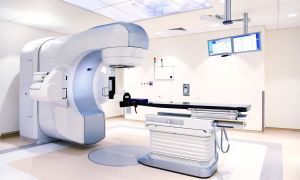The contraction stress test (CST) is used to determine if there are adequate fetal reserves prior to the onset of labor by evaluating the response of the fetal heart rate to spontaneous or induced uterine contractions. The goal of a CST is to induce uterine contractions and to evaluate the fetal response.
In a contraction stress test, a fetal heart rate monitor and uterine contraction monitor are placed around the maternal abdomen, and the fetal heart rate response to contractions is noted. The contractions may be spontaneous or induced through nipple stimulation and administration of oxytocin through an intravenous solution. In a healthy pregnancy, the placenta has the capacity to transport oxygen from maternal to fetal blood. If the placenta is compromised, less oxygen may be transported. A compromised placenta becomes evident when the uterus contracts and the vessels to the placenta are compressed, limiting blood flow and oxygen delivery. If oxygen passage across the placenta drops too much, the fetus responds with a decrease in heart rate. If the decrease in the fetal heart rate meets pre-determined criteria the CST is “Positive”. It there is no decrease in the fetal heart rate, the CST is negative. A negative CST is a reassuring finding whereas a positive CST is a sign that the fetus may not be receiving adequate oxygen and nutrients.
A CST is usually not performed if there are signs of premature labor, placenta previa, premature rupture of the membrane, incompetent cervix, or previous uterine incision or any other condition which makes labor contraindicated. One of the risks of a CST is that one initiated the uterine contraction will not cease and the labor will progress to birth of the fetus. In many settings a biophysical profile has replaced the CST, because it eliminated the concern related to onset of labor.
Continue Learning about Diagnostic Procedures
Important: This content reflects information from various individuals and organizations and may offer alternative or opposing points of view. It should not be used for medical advice, diagnosis or treatment. As always, you should consult with your healthcare provider about your specific health needs.

